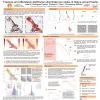Poster #150, Fault and Rupture Mechanics (FARM)
Scale-dependent fault roughness effects on earthquake dynamics and ground-motion
Poster Image:

Poster Presentation
2020 SCEC Annual Meeting, Poster #150, SCEC Contribution #10230 VIEW PDF
t rupture fronts and higher variability of rupture speed. We also observe a systematic change in the spectral fall-off of peak slip rate clearly associated with the process zone size highlighting its importance in modulating fault roughness dynamic effects. On the other hand, the spectral content of other rupture characteristics is consistently fractal over all scales, suggesting that such criticality is not an intrinsic characteristic of fault roughness effects.
The numerical cost of dynamic rupture models across rough faults may greatly depend on the smallest resolved deviation from fault planarity. Based on our findings, we develop strategies to emulate the full dynamic behavior in a hybrid approach, combining small scale traction and strength heterogeneity with larger-scale geometric complexity. We show that such hybrid dynamic rupture models can capture larger-scale rupture kinematic characteristics of the geometrically fully complex model if fault strength is scaled accordingly. By also introducing scaled heterogeneities in traction, small-scale dynamic variations of fault slip and rupture velocity can be emulated. This strategy produces high-frequency synthetic ground motions of up to 10~Hz comparable, in terms of spectral acceleration and velocity waveforms, with the fully complex dynamic rupture synthetics.
Our results advance our understanding of fault roughness effects on dynamic rupture and high-frequency ground motions and the scales these are acting upon. This allows to develop strategies towards computationally efficient physics-based seismic hazard characterisation based on integrating the synthetics of large ensembles of dynamic rupture simulations across rough faults.
SHOW MORE
The numerical cost of dynamic rupture models across rough faults may greatly depend on the smallest resolved deviation from fault planarity. Based on our findings, we develop strategies to emulate the full dynamic behavior in a hybrid approach, combining small scale traction and strength heterogeneity with larger-scale geometric complexity. We show that such hybrid dynamic rupture models can capture larger-scale rupture kinematic characteristics of the geometrically fully complex model if fault strength is scaled accordingly. By also introducing scaled heterogeneities in traction, small-scale dynamic variations of fault slip and rupture velocity can be emulated. This strategy produces high-frequency synthetic ground motions of up to 10~Hz comparable, in terms of spectral acceleration and velocity waveforms, with the fully complex dynamic rupture synthetics.
Our results advance our understanding of fault roughness effects on dynamic rupture and high-frequency ground motions and the scales these are acting upon. This allows to develop strategies towards computationally efficient physics-based seismic hazard characterisation based on integrating the synthetics of large ensembles of dynamic rupture simulations across rough faults.
SHOW MORE























































